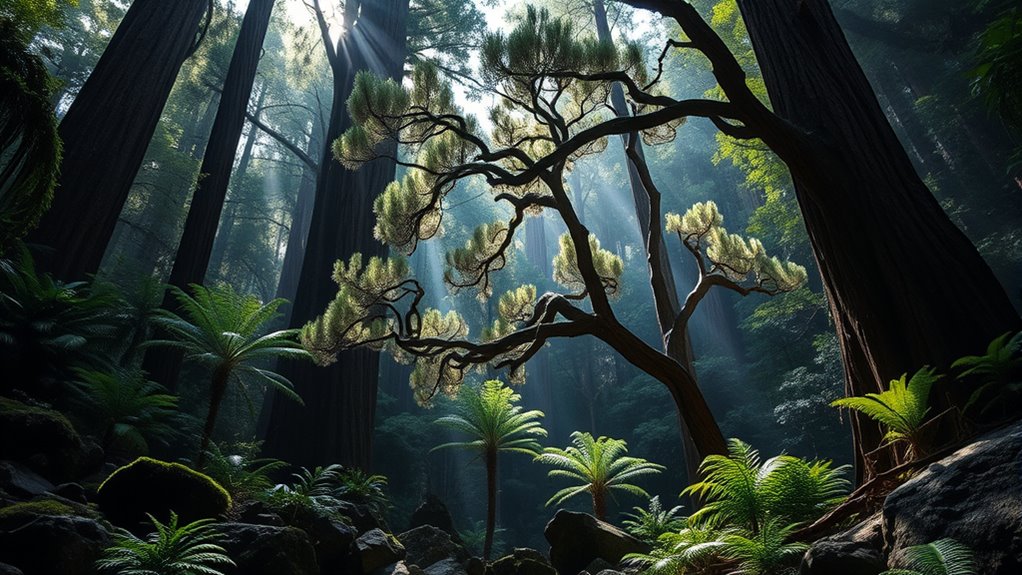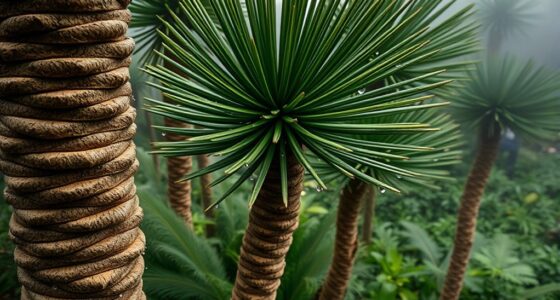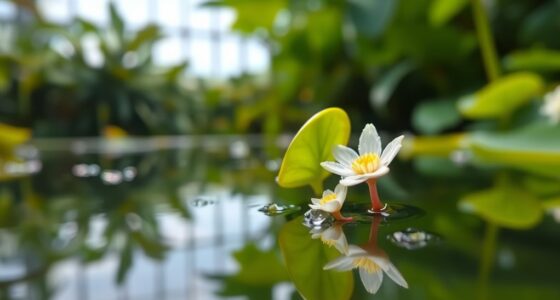In 1994, scientists uncovered the Wollemi Pine’s secret valley deep in Australia’s Blue Mountains, protecting this ancient ‘dinosaur’ tree from poaching. With its bubbly bark and fern-like leaves, it’s a living relic dating back 200 million years. Conservation efforts have propagated the species worldwide, ensuring its survival. If you want to discover how this incredible discovery was preserved and what makes it so special, keep exploring its fascinating story.
Key Takeaways
- The Wollemi Pine was discovered in 1994 deep within a remote Blue Mountains valley, remaining a secret to protect it from poaching.
- Its ancient lineage dates back approximately 200 million years, earning it the nickname “dinosaur tree.”
- Conservation efforts focused on propagating trees in nurseries to ensure survival beyond the fragile wild habitat.
- The species symbolizes resilience, with ongoing scientific monitoring and efforts to preserve its genetic diversity.
- The secret valley remains protected, highlighting the importance of conservation and natural heritage preservation.

Hidden deep within a remote valley, the Wollemi Pine remains one of the world’s most extraordinary botanical discoveries. When you first hear about this ancient tree, it’s hard not to feel a sense of wonder. Imagine stumbling upon a piece of prehistoric Earth, a living relic that has survived millions of years largely untouched by human hands. That’s exactly what happened when a small team of scientists uncovered the Wollemi Pine in 1994, deep in the Blue Mountains of Australia. The discovery was like finding a lost world, a tree thought to have vanished long before humans walked the Earth.
Hidden in a remote valley, the Wollemi Pine is one of the world’s most astonishing botanical discoveries.
You might wonder why this tree is such a big deal. Well, it’s because the Wollemi Pine is often called a “dinosaur tree,” and for good reason. Its lineage dates back around 200 million years, making it a relic from the age of the dinosaurs. Its unique, bubbly bark and fern-like leaves give it an otherworldly appearance, unlike any other modern conifer. Because it’s so rare and mysterious, scientists quickly recognized the importance of protecting it. Once the location was kept secret to prevent poaching or over-collection, conservation efforts began to focus on saving this botanical treasure.
You could be involved in the ongoing story of its rescue. After the initial discovery, botanists and conservationists worked tirelessly to propagate the Wollemi Pine in nurseries, ensuring it wouldn’t disappear entirely. They faced numerous challenges—its tiny seedling count, its specific growing needs, and the risk of losing genetic diversity. Yet, through careful cultivation and research, they managed to grow more trees, giving hope that the species could survive beyond its wild habitat. Today, thanks to these efforts, the Wollemi Pine is available for purchase, allowing enthusiasts and botanical gardens worldwide to cultivate it, spreading its legacy further.
You might also feel inspired to learn more about its protection. The secret valley where it was found remains a protected area, carefully guarded to preserve its fragile environment. Every year, scientists and conservationists return to study and monitor the trees, enthusiastic to ensure that this ancient species remains part of our planet’s living heritage. The story of the Wollemi Pine reminds you of nature’s resilience and the importance of safeguarding our natural history. It’s a symbol of how human curiosity and dedication can rescue a species teetering on the brink of extinction, transforming it from a hidden relic into a symbol of hope for the future of biodiversity. Promoting sustainable foraging and conservation practices is vital to maintaining the ecosystem health that supports such rare species.
Frequently Asked Questions
How Long Does It Take for a Wollemi Pine to Mature?
A Wollemi pine typically takes about 10 to 20 years to reach maturity, but some may take longer depending on growing conditions. You might notice it growing slowly at first, but with proper care, it can grow steadily over time. Keep in mind that these trees are quite rare and slow-growing, so patience is key. As it matures, you’ll see it develop its distinctive, fern-like foliage and impressive stature.
Are Wollemi Pines Resistant to Pests and Diseases?
Think of the Wollemi Pine as a tiny fortress against pests and diseases. It’s remarkably resistant, standing strong like a seasoned warrior amid threats. While no tree is completely immune, your Wollemi Pine generally fights off common pests and ailments well. Proper care, like good watering and healthy soil, boosts its defenses. So, with the right attention, you help your ancient-looking tree thrive in its natural battle against pests and diseases.
Can Wollemi Pines Be Grown Outside Their Native Habitat?
Yes, you can grow Wollemi pines outside their native habitat, but they need specific conditions to thrive. You should plant them in well-drained soil with plenty of organic matter, and guarantee they get partial shade or protection from harsh sun. Keep the soil consistently moist, and maintain a cool, humid environment. With proper care, your Wollemi pine can adapt and flourish in suitable non-native locations.
What Role Did Indigenous Communities Play in the Discovery?
You should know that indigenous communities played a vital role in the discovery of the Wollemi Pine. They knew the land intimately and recognized the significance of the area’s unique flora. When explorers first heard about the trees, it was often through indigenous guides who shared their knowledge. Their deep connection to the land helped uncover this ancient treasure, proving that sometimes, local wisdom is worth its weight in gold.
Are There Any Conservation Efforts Beyond the Rescue?
Yes, conservation efforts extend beyond the rescue. You can support ongoing protection by donating to organizations dedicated to preserving Wollemi Pines and their habitat. Participate in local and global awareness campaigns to highlight the importance of this ancient species. You might also help by spreading knowledge about their significance and the need for habitat conservation, ensuring these ‘dinosaur’ trees thrive for future generations. Your involvement makes a difference.
Conclusion
So, here you are, marveling at how a tiny, hidden valley saved a tree once thought extinct—like finding a real dinosaur tucked away in your backyard. It’s ironic, really. We went from hunting for new species to protecting one that survived millions of years in secret. The Wollemi Pine’s story proves that sometimes, the greatest treasures are the ones hiding right under your nose—if you’re lucky enough to find them.










